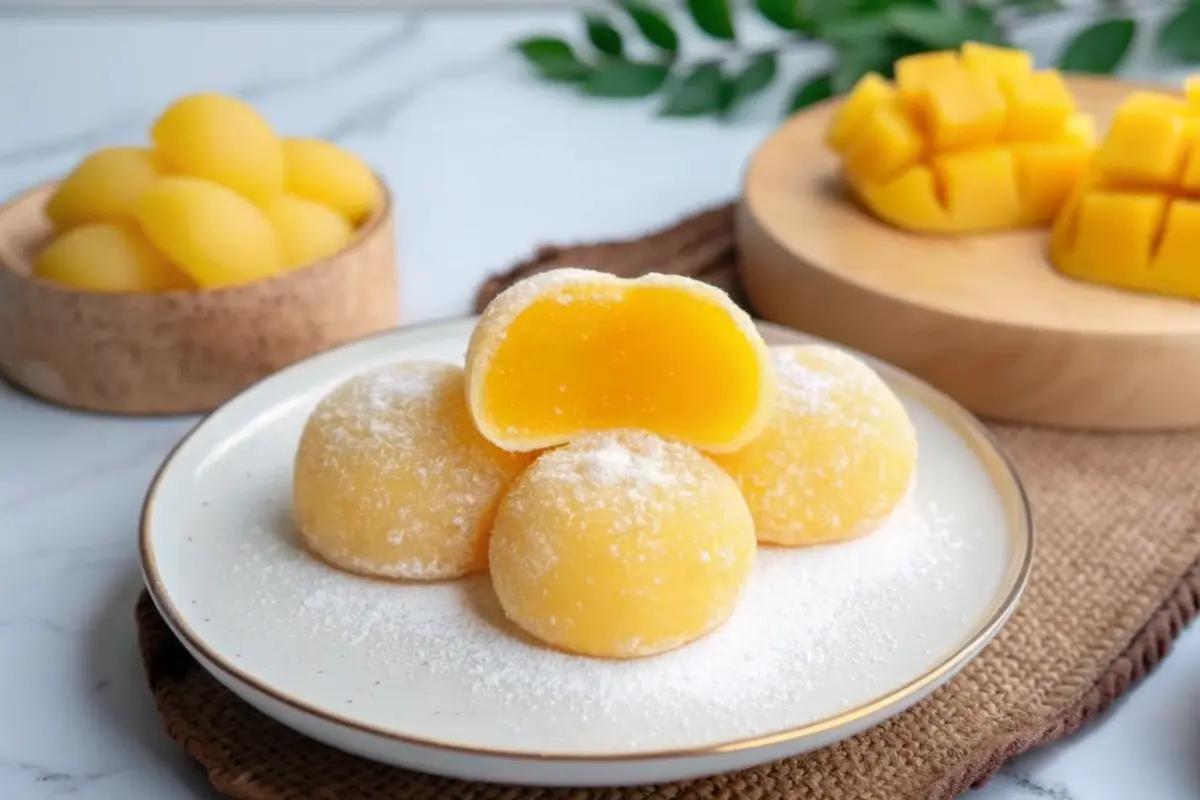Bouncy-chewy on the outside, lush mango in the center, and a sunny golden glow that makes every bite feel like a tropical escape—Golden Mango Mochi is the little dessert that always steals the show. This guide walks you through everything you need to know: what it is, how to make it with or without a microwave, assembly tricks, texture control, storage, plus creative variations (hello, mango-cheesecake mochi!). If you’re after the best, most reliable method for homemade mango mochi, you’re in the right place.
What Is Golden Mango Mochi?
Golden Mango Mochi—sometimes called mango daifuku—is a soft, stretchy rice-flour dough wrapped around a fresh mango center (or mango cream). The “golden” part is a nod to the vibrant mango color. Traditional daifuku usually features sweet bean paste, but fruit-filled versions have become wildly popular for their fresh, juicy bite and photogenic cross-sections. Think of it as a handheld mango pillow with a gleaming, tropical heart.
At a glance:
- Outer layer: tender, chewy mochiko dough
- Filling: fresh mango cubes, thick mango purée, or mango-infused cream
- Finish: dusted with starch or coconut flakes; optionally topped with edible gold leaf for extra “golden” drama
Ingredients for Golden Mango Mochi
Understanding ingredients is the key to predictable texture and clean assembly.
- Glutinous rice flour (mochiko, sweet rice flour): Provides elasticity and that springy bite. Do not substitute regular rice flour.
- Fresh ripe mango: Choose varieties with low fiber and natural sweetness (e.g., Ataulfo, Alphonso, Kent). Chill your mango for cleaner wrapping.
- Sugar: Sweetens and helps retain moisture.
- Liquid: Water is classic; coconut milk adds tropical richness and a creamier chew.
- Neutral oil or butter (optional): A tiny bit improves tenderness and makes the dough easier to handle.
- Cornstarch or potato starch (for dusting): Prevents sticking, especially during shaping. Lightly toasting the starch can add a subtle nutty aroma.
- Flavor lifts (optional): Vanilla, a pinch of salt, a whisper of lime zest, or minced coconut flakes folded into the dusting.
Pro-tip: If your mango is very juicy, plan a two-step filling approach: pat-dry mango cubes and/or thicken purée (reduce over low heat, cool completely) for a less “slippery” center.
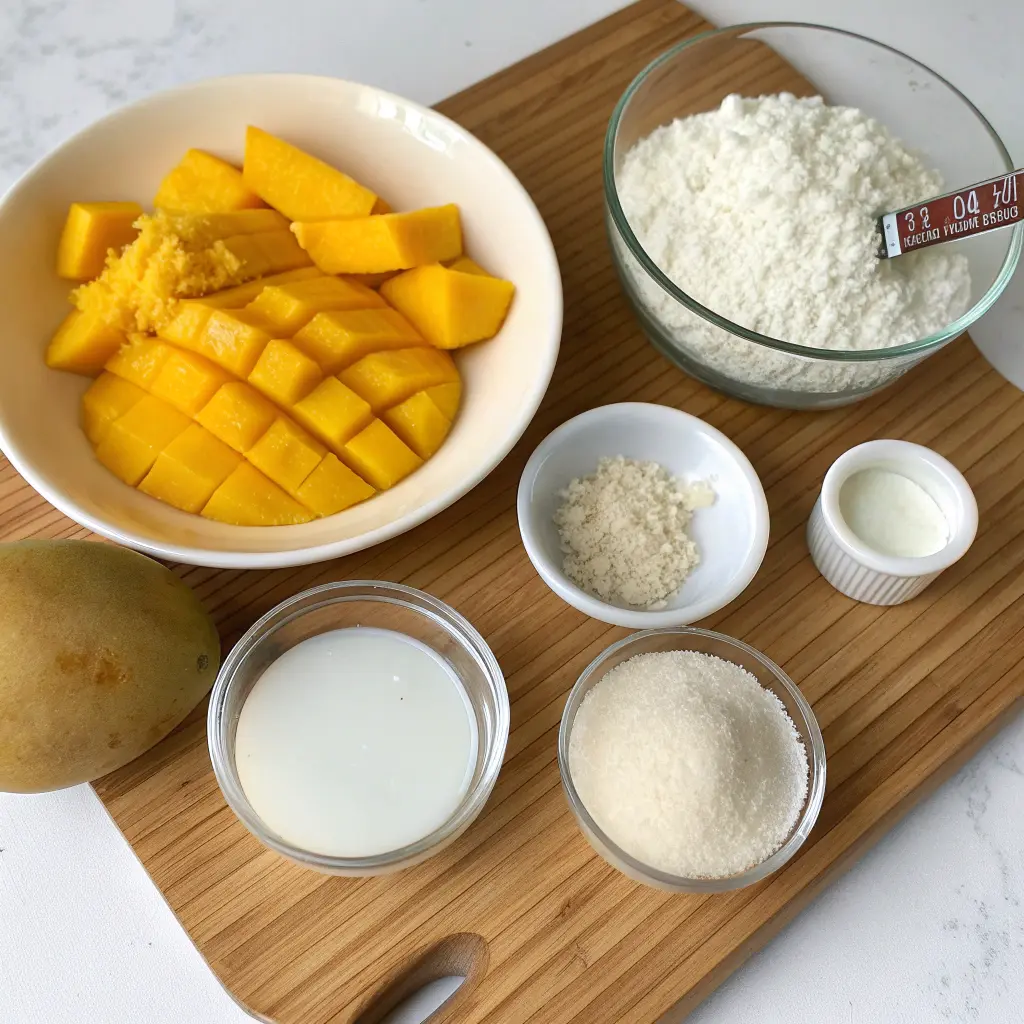
Equipment & Setup
- Heatproof mixing bowl (for microwave) or medium saucepan/steamer setup (for stovetop/steam method)
- Silicone spatula or sturdy wooden spoon
- Kitchen scale (for accurate ratios)
- Plastic wrap or lid (for microwaving/steaming)
- Starch-dusted surface (silicone mat or board)
- Disposable gloves (oiled very lightly) for handling sticky dough
- Cupcake liners (to keep mochi from sticking to plates and to look neat)
Set up a “wrapping station”:
- Starch-dusted board
- Portioning tool (small scoop or knife)
- Mango cubes/cream filling (chilled)
- Liners ready for finished pieces
The Two Core Methods (Microwave vs. Stovetop/Steam)
Both methods produce excellent dough—choose based on your tools and comfort.
Microwave Method: Fast & Beginner-Friendly
- Mix dry ingredients and liquid, whisking until smooth (no lumps).
- Cover (plastic wrap with vent) and heat in short bursts (e.g., 45–60 seconds), stirring between rounds until dough is glossy and evenly translucent.
- Finish with a brief stir/knead using a silicone spatula to align the starch gel for elasticity.
Stovetop/Steam Method: Precise & Traditional
- Cook-stir method (no microwave): Add liquid to dry mix in a saucepan and stir constantly over medium-low heat until the mixture thickens, pulls from the sides, and turns shiny-translucent.
- Steamed batter method: Steam the covered batter for 12–20 minutes (depending on batch size) until glossy and set, then stir/knead warm with a spatula.
Doneness cues (for both):
- Dough looks translucent rather than chalky
- Dough feels springy-elastic and pulls away from the bowl/sides
- It holds together in a cohesive mass without wet spots
Choosing & Prepping Mango
Mango is your flavor headline—choose well.
- Ripeness: Slight give at the stem end, fragrant aroma, rich color for the variety
- Texture: Prefer lower-fiber varieties for clean cuts and less stringiness
- Prep:
- For cubes: cut into 1.5–2 cm pieces; pat dry; chill 15–20 minutes
- For purée: blend, then reduce gently to thicken; cool completely
- For cream fillings: fold mango purée into whipped cream or mascarpone; chill until scoopable
Filling formats:
- Classic mango cubes (cleanest cross-section)
- Mango cream for a mousse-like center
- Giant whole-fruit mochi (a dramatic showpiece—use firmer wedges and a larger dough portion)
Step-by-Step: Microwave Mango Mochi Dough
- Whisk Dry: 100 g glutinous rice flour, 30–35 g sugar, and a tiny pinch of salt (optional).
- Add Liquid: 100 g water or coconut milk (start with 95 g; add more by the teaspoon if needed). Whisk smooth.
- Cover & Heat: Microwave 45–60 seconds, stir, then 30–45 seconds more. Repeat in short bursts, stirring each time, until glossy and translucent throughout (no floury streaks).
- Finish & Rest: Stir vigorously with a silicone spatula for 20–30 seconds. Turn onto a starch-dusted surface. Cool until warm-pliable, not hot.
- Knead Briefly: With lightly oiled gloves, fold the dough over itself a few times to even out texture. Don’t overwork.
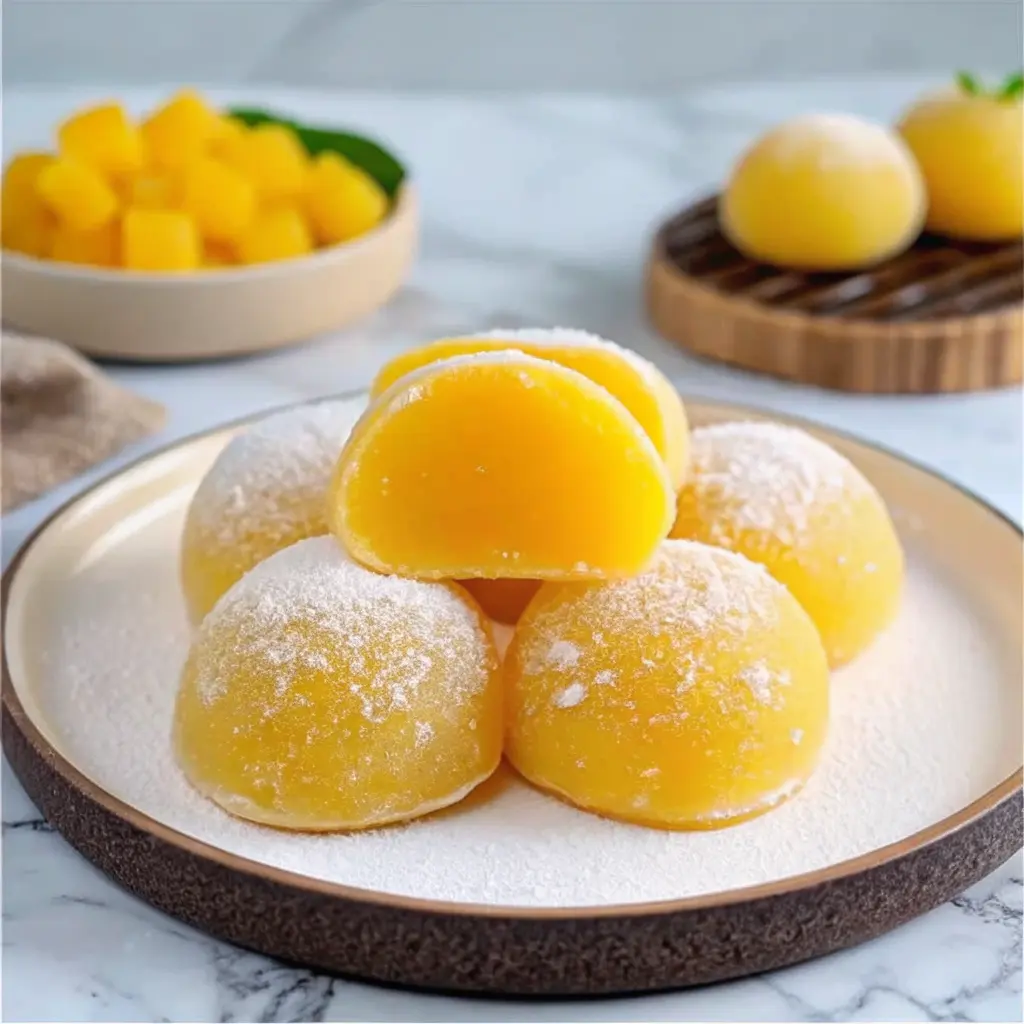
Step-by-Step: Stovetop/Steamed Dough
Cook-Stir (No Microwave):
- Combine flour, sugar, and liquid in a saucepan; whisk smooth.
- Cook over medium-low heat, stirring constantly. The mix thickens, turns shiny, and starts pulling away from the pan.
- Keep stirring 30–60 seconds after it turns uniformly translucent. Transfer to a starch-dusted surface; cool until warm-pliable.
Steamed Batter Method:
- Whisk batter smooth; pour into a shallow, greased, heatproof dish.
- Cover tightly and steam 12–20 minutes (size-dependent) until the batter becomes glossy and translucent.
- Use a spatula to fold/knead the cooked mass briefly; turn out and cool to a warm, pliable state.
Assembly & Wrapping (Clean, Round, Seamless)
- Portion Dough: Dust hands lightly. Divide warm dough into 6–8 pieces (or more for minis). Keep unused pieces covered.
- Flatten: Press each piece into a disc 2–3 mm thick.
- Fill: Add a chilled mango cube or a teaspoon of mango cream.
- Seal: Pinch edges together gently. If dough sticks to fingers, add the tiniest dusting of starch or use lightly oiled gloves.
- Shape: Turn seam-side down; cup your hands and roll lightly to smooth.
- Rest & Set: Place in liners; chill 15–30 minutes to help the seam set. Dust again if needed.
Wrapping tips:
- Keep dough warm (not hot); cold dough tears more easily
- Work quickly; mango warmth softens dough
- If a hole forms, patch with a thin scrap of dough and dust very lightly
Flavor Variations & Fillings
- Mango-Coconut Cream: Fold thick mango purée into lightly sweetened whipped cream or mascarpone; chill before wrapping.
- Mango Cheesecake Mochi: Soften cream cheese with sugar and vanilla; swirl in mango purée for a marbled center.
- Mango Butter Mochi Bars (Baked Variant): A different mochi style—custardy bars baked with coconut milk and sweet rice flour. Serve bars alongside classic mango mochi for a fun dessert duo.
- Spiced Mango: Add cardamom and lime zest to the dough; finish with coconut dusting.
- Whole-Mango Showpiece: Wrap a firm mango wedge with a larger dough portion; chill longer for a flawless slice.
Troubleshooting
- Dough too sticky: Cook a touch longer; dust minimally with starch while shaping.
- Dough tearing: It’s either too cool or slightly undercooked. Re-warm briefly (microwave 8–10 seconds) or knead warm.
- Filling leaking: Mango too juicy. Pat dry thoroughly; for purée, reduce to thicken and cool completely.
- Gummy bite: Under-gelatinized starch. Continue cooking until fully translucent.
- Grainy texture: Batter wasn’t fully smoothed before heating; whisk until silky next time.
- Too sweet or too bland: Adjust sugar in 5 g increments; flavor lifts (vanilla, lime zest) can sharpen the profile without extra sweetness.
Make-Ahead, Storage & Serving
- Best day-of: Mochi is at its most supple shortly after assembly and a brief chill.
- Short-term storage: Refrigerate in airtight containers with a light dusting of starch to prevent sticking.
- Freezer notes (cream fillings): Freeze on a tray until firm, then bag. Thaw in the refrigerator until just pliable.
- Serving temperature: Slightly cool or room temperature brings back the springy chew.
- Plating ideas: Slice a few in half to display the golden mango center; scatter mango fans, coconut snow, and a pinch of edible gold.
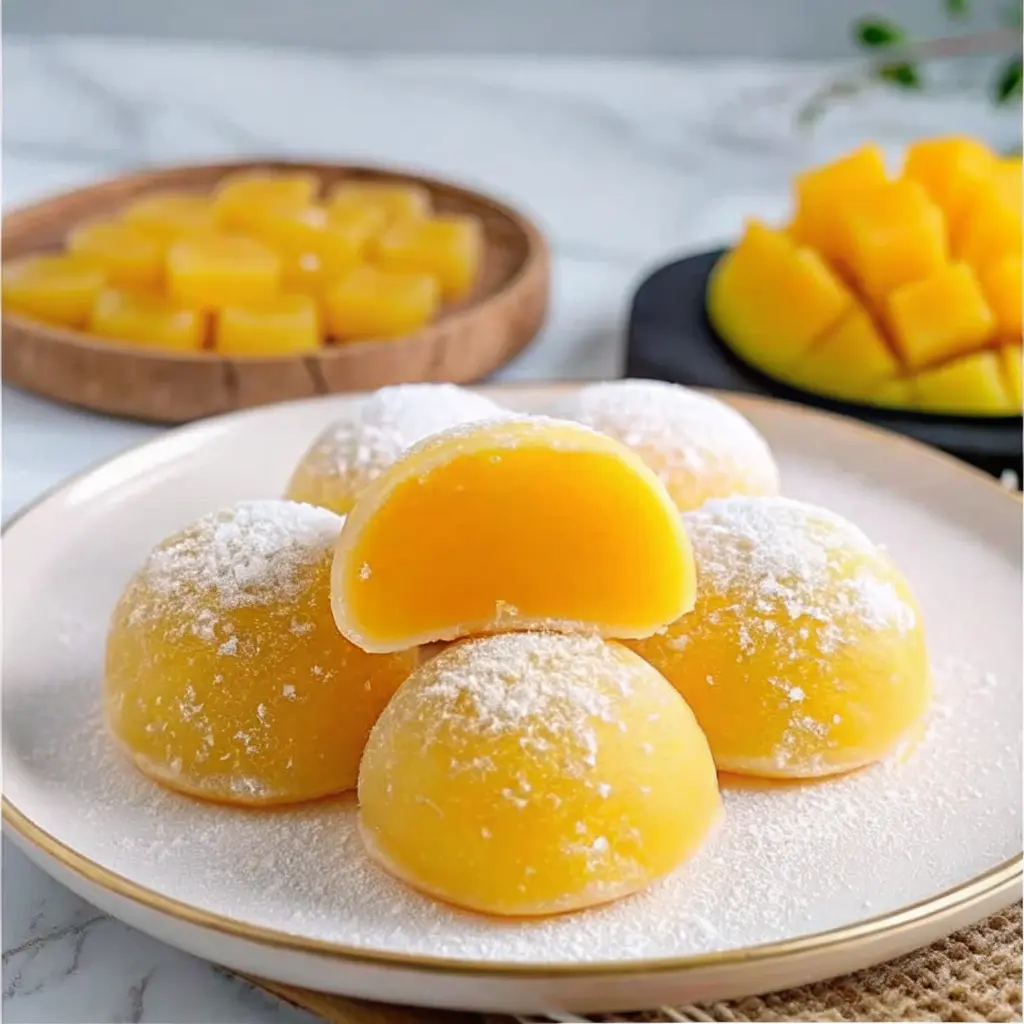
FAQs
1) Can I use regular rice flour instead of glutinous rice flour?
No. Regular rice flour lacks the unique starches that create mochi’s signature chew. Always use glutinous rice flour (mochiko).
2) Microwave vs. stovetop—what’s easier for beginners?
The microwave is faster and very consistent for small batches. Stovetop offers a traditional feel and precise control once you get used to the translucent doneness cue.
3) How do I keep mochi from sticking to everything?
Use a light starch dusting, work with warm dough, and consider lightly oiled gloves. Keep finished pieces in cupcake liners.
4) Which mango varieties work best?
Look for sweet, low-fiber mangoes like Ataulfo, Alphonso, or Kent. Chill the fruit for cleaner wrapping.
5) How thick should the mochi skin be?
Aim for 2–3 mm—thin enough for a delicate bite, but thick enough to seal without tearing.
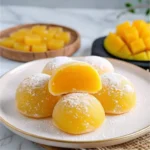
Golden Mango Mochi Recipe
- Total Time: PT40M
- Yield: 12 pieces 1x
- Diet: Vegetarian
Description
This Golden Mango Mochi is a chewy, silky Japanese-inspired dessert filled with luscious mango flavor. Each bite offers a tender mochi shell with a juicy mango center — a refreshing, tropical treat perfect for summer or any time you crave something sweet and unique.
Ingredients
For the Mochi Dough:
- 1 cup glutinous rice flour (Mochiko or shiratamako)
- ¾ cup water
- ¼ cup sugar
- ½ cup coconut milk (optional for richer flavor)
- 1 tsp mango extract or puree for color and flavor
For the Filling:
- 1 ripe mango, diced (or ½ cup mango puree)
- ½ cup whipped cream or vanilla ice cream (for frozen version)
For Dusting:
- ½ cup cornstarch or potato starch (to prevent sticking)
Instructions
- Prepare the filling:
- Dice mango into small cubes or blend into puree.
- If using whipped cream, freeze small dollops with mango pieces for 30 minutes to make shaping easier.
- Make the mochi dough:
- In a microwave-safe bowl, whisk together glutinous rice flour, sugar, water, and coconut milk (if using).
- Add mango extract or puree and mix until smooth.
- Cook the mochi:
- Microwave on high for 1 minute, stir, then repeat in 30-second intervals until the dough becomes thick, sticky, and slightly translucent (about 2½–3 minutes total).
- Cool and dust:
- Allow the mochi to cool slightly, then transfer to a cornstarch-dusted surface. Coat the top with starch to prevent sticking.
- Shape the mochi:
- Divide into 12 portions. Flatten each piece into a circle about 3 inches wide.
- Place a spoonful of mango or the frozen mango-cream filling in the center.
- Carefully pinch edges to seal and shape into smooth balls.
- Chill and serve:
- Refrigerate for 30 minutes before serving for a soft texture, or freeze for 1–2 hours for a firmer, ice-cream-style version.
- Prep Time: PT25M
- Cook Time: PT15M
- Category: Desserts
- Method: Steamed
- Cuisine: Japanese
Nutrition
- Serving Size: 1 mochi ball
- Calories: 120 kcal
- Sugar: 10g
- Sodium: 10mg
- Fat: 3g
- Saturated Fat: 2g
- Unsaturated Fat: 1g
- Trans Fat: 0g
- Carbohydrates: 22g
- Fiber: 1g
- Protein: 2g
- Cholesterol: 0mg

